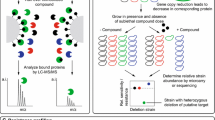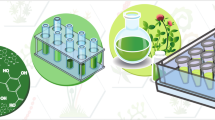Abstract
Natural product compounds are the source of numerous therapeutic agents. Recent progress to discover drugs from natural product sources has resulted in compounds that are being developed to treat cancer, resistant bacteria and viruses and immunosuppressive disorders. Many of these compounds were discovered by applying recent advances in understanding the genetics of secondary metabolism in actinomycetes, exploring the marine environment and applying new screening technologies. In many instances, the discovery of a novel natural product serves as a tool to better understand targets and pathways in the disease process. This review describes recent progress in drug discovery from natural sources including several examples of compounds that inhibit novel drug targets.













Similar content being viewed by others
References
Belenky A, Hughes D, Korneev A, Dunayevskiy Y (2004) Capillary electrophoretic approach to screen for enzyme inhibitors in natural extracts. J Chromatogr A 1053(1–2):247–251
Besemer J, Harant H, Wang S, Oberhauser B, Marquardt K, Foster CA, Schreiner EP, de Vries JE, Dascher-Nadel C, Lindley IJ (2005) Selective inhibition of cotranslational translocation of vascular cell adhesion molecule 1. Nature 436(7048):290–293
Butler MS (2004) The role of natural product chemistry in drug discovery. J Nat Prod 67:2141–2153
Butler MS (2005) Natural products to drugs: natural product compounds in clinical trials. Nat Prod Rep 22:162–195
Charan RD, Schlinghann G, Janso J, Bernan V, Feng X, Carter GT (2004) Diazepinomicin, a new antimicrobial alkaloid from a marine Micromonospora sp. J Nat Prod 67(8):1431–1433
Chauhan D, Catley L, Li G, Podar K, Hideshima T, Velankar M, Mitsiades C, Mitsiades N, Yasui H, letai A, Ovaa H, Berkers C, Nicholson B, Chao T-H, Neuteboom STC, Richardson P, Palladino M, Anderson KC (2005) A novel orally active proteasome inhibitor induces apoptosis in multiple myeloma cells with mechanisms distinct from Bortezomib. Cancer Cell 8:407–419
Cheng Z, Jiang Y, Mandon EC, Gilmore R (2005) Identification of cytoplasmic residues of Sec61p involved in ribosome binding and cotranslational translocation. J Cell Biol 168(1):67–77
Chiba K (2005) FTY720, a new class of immunomodulator, inhibits lymphocyte egress from secondary lymphoid tissues and thymus by agonistic activity at sphingosine 1-phosphate receptors. Pharmacol Ther 108(3):308–319
Feling RH, Buchanan GO, MincerTJ, Kauffman CA, Jensen PR, Fenical W (2003) Salinosporamide A: a highly cytotoxic proteasome inhibitor from a novel microbial source, a marine bacterium of the new genus salinospora. Angew Chem Int Ed Engl 42(3):355–357
Garrison JL, Kunkel EJ, Hegde RS, Taunton J (2005) A substrate-specific inhibitor of protein translocation into the endoplasmic reticulum. Nature 436(7048):285–289
Gravestock MB (2005) Recent developments in the discovery of novel oxazolidinone antibacterials. Curr Opin Drug Discov Devel 8(4):469–477
Jain R, Chen D, White RJ, Patel DV, Yuan Z (2005) Bacterial Peptide deformylase inhibitors: a new class of antibacterial agents. Curr Med Chem 12(14):1607–1601
Kahan BD (2004) FTY720: from bench to bedside. Transplant Proc 36(2 Suppl):531S–543S
Koehn FE, Carter GT (2005) The evolving role of natural products drug discovery. Nat Rev 4:206–220
Kristeleit R, Stimson L, Workman P, Aherne W (2004) Histone modification enzymes: novel targets for cancer drugs. Expert Opin Emerg Drugs 9(1):135–154
Kung AL, Zabludoff SD, France DS, Freedman SJ, Tanner EA, Vieira A, Cornell-Kennon S, Lee J, Wang B, Wang J, Memmert K, Naegeli HU, Petersen F, Eck MJ, Bair KW, Wood AW, Livingston DM (2004) Small molecule blockade of transcriptional coactivation of the hypoxia-inducible factor pathway. Cancer Cell 6(1):33–43
Lepourcelet M, Chen YN, France DS, Wang H, Crews P, Petersen F, Bruseo C, Wood AW, Shivdasani RA (2004) Small-molecule antagonists of the oncogenic Tcf/beta–catenin protein complex. Cancer Cell 5(1):91–102
Levy SB, Marshall B (2004) Antibacterial resistance worldwide: causes, challenges and responses. Nat Med 10(12 Suppl):S122–S129
Livermore DM (2004) The need for new antibiotics. Clin Microbiol Infect 10(Suppl 4):1–9
Macherla VR, Mitchell SS, Manam RR, Reed KA, Chao TH, Nicholson B, Deyanat-Yazdi G, Mai B, Jensen PR, Fenical WF, Neuteboom ST, Lam KS, Palladino MA, Potts BC (2005) Structure–activity relationship studies of salinosporamide A (NPI-0052), a novel marine derived proteasome inhibitor. J Med Chem 48(11):3684–3687
Mullady EL et al (2004) A phthalide with in vitro growth inhibitory activity from an oidiodendron strain. J Nat Prod 67(12):2086–2099
Neckers L, Neckers K (2002) Heat-shock protein 90 inhibitors as novel cancer chemotherapeutic agents. Expert Opin Emerg Drugs 7(2):277–288
Newman DJ, Cragg GM, Snader KM (2000) The influence of natural products upon drug discovery. Nat Prod Rep 17:215–234
Newman DJ, Cragg GM, Snader KM (2003) Natural products as sources of new drugs over the period 1981–2002. J Nat Prod 66:1022–1037
Nicholson B, Lloyd GK, Miller BR, Palladino MA, Kiso Y, Hayashi Y, Neuteboom STC (2006) NPI-2358 is a tubulin-depolymerization agent: in vitro evidence for activity as a tumor vascular-disrupting agent. Anticancer Drugs 17(1):25–31
Ostrander JM, Hurley LH, McInnes AG, Smith DG, Walter JA, Wright JL (1980) Proof for the biosynthetic conversion of l-[indole-15 N]tryptophan to [10–15 N]anthramycin using (13C, 15 N) labelling in conjunction with 13C-NMR and mass spectral analysis. J Antibiot (Tokyo) 33(10):1167–1171
Overbye KM, Barrett JF (2005) Antibiotics: where did we go wrong? Drug Discov Today 10(1):45–52
Pierceall WE et al (2004) Affinity capillary electrophoresis analyses of protein–protein interactions in target-directed drug discovery. Methods Mol Biol 261:187–198
Whitesell L, Lindquist SL (2005) HSP90 and the chaperoning of cancer. Nat Rev Cancer 5(10):761–772
Author information
Authors and Affiliations
Corresponding author
Rights and permissions
About this article
Cite this article
Gullo, V.P., McAlpine, J., Lam, K.S. et al. Drug discovery from natural products. J IND MICROBIOL BIOTECHNOL 33, 523–531 (2006). https://doi.org/10.1007/s10295-006-0107-2
Received:
Accepted:
Published:
Issue Date:
DOI: https://doi.org/10.1007/s10295-006-0107-2




